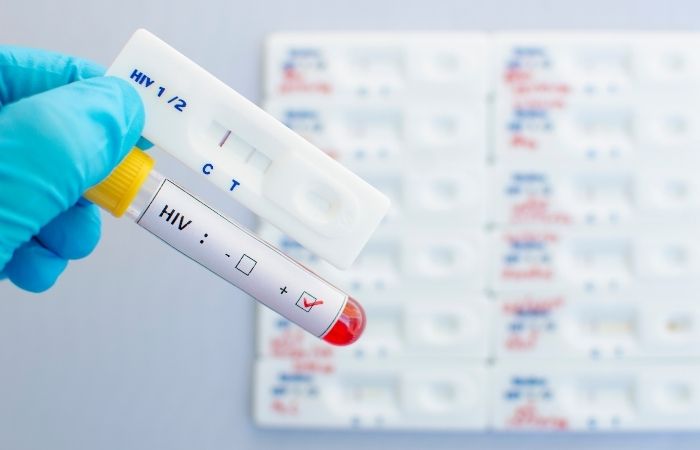Chlamydia Swab Tests Explained: Accuracy, Pain, and Home Kit Options
Quick Answer
UTIs and STDs often share symptoms like painful urination and pelvic discomfort. If UTI treatments don’t work, it might be an STD like Chlamydia or Gonorrhea, both of which can mimic UTI symptoms. Testing is the only way to know for sure.
When a UTI Isn’t Actually a UTI
The Symptom Swap That Fools Everyone
Here’s the hard truth: Chlamydia, Gonorrhea, Trichomoniasis, and even Genital Herpes can all masquerade as urinary tract infections, especially in women. The overlapping symptoms are frustratingly identical:
- Burning during urination
- Frequent urge to pee
- Lower abdominal pain
- Cloudy or strange-smelling urine
One study from the Journal of Clinical Microbiology found that over 50% of women diagnosed with a UTI in emergency departments were never actually tested for STDs, and many later turned out to have one.
Here’s Why That Happens
- Fast assumptions: Doctors often skip STD testing when patients report typical UTI symptoms.
- Embarrassment: Patients don’t always mention recent sexual activity, especially if it feels taboo or complicated.
- Overlap in anatomy: In people with vaginas, the urethra and reproductive tract are close neighbors, making cross-symptom confusion more likely.
UTIs are common. So are STDs. And sometimes, they're not mutually exclusive.

Case Study: “I Thought It Was Just Another UTI…”
Rachel, 29, had recurring UTIs since college. She knew the drill, pee after sex, drink cranberry juice, call in her antibiotic prescription.
Except this time, the symptoms didn’t go away.
Weeks passed. Then came a call from her recent partner: he’d tested positive for Chlamydia.
“I was embarrassed. Not just that I had an STD, but that I hadn’t considered it. I was so sure it was a UTI because it felt just like the others.”
Rachel isn’t alone. In one survey, 70% of women with Chlamydia said they didn’t realize they had it because it mimicked something else, or had no symptoms at all.
Moral of the story: Even if it feels like a UTI, it could still be an STD. Especially if you’re sexually active.
Why Standard UTI Treatments Can Make STDs Worse
Antibiotics Aren’t One-Size-Fits-All
Most uncomplicated UTIs get treated with antibiotics like trimethoprim-sulfamethoxazole or nitrofurantoin. These work well for E. coli, the bacteria behind most urinary infections, but they’re not effective against Chlamydia or Gonorrhea.
So if you’ve got one of those STDs and take a UTI-targeted antibiotic? You’re not just untreated, you might be masking symptoms temporarily and giving the infection more time to spread.
That’s how pelvic inflammatory disease (PID) starts. That’s how fertility issues creep up years later. That’s how STDs stay invisible but active.
Order Now $129.00 $343.00 Check Your STD Status in Minutes
Test at Home with Remedium
7-in-1 STD Test Kit




For all 7 tests
Why UTI Symptoms Don’t Always Mean a UTI
Symptom Match Doesn’t Equal Cause
Let’s be real, your bladder doesn’t come with a symptom legend. Burning, pressure, urgency... those could point to a dozen different conditions. And if your symptoms return even after treatment, or never fully go away, something’s off.
Here’s what that could mean:
- You were treated for the wrong thing: A misdiagnosed STD means the real infection is still active.
- You have both a UTI and an STD: Yes, they can tag-team your system, especially after sex.
- You’ve developed antibiotic resistance: Repeated treatments may make UTIs harder to clear.
- Your partner wasn’t treated: Re-infection is common when only one person gets care.
If your so-called “UTI” feels suspiciously stubborn, it's time to widen the lens.
Testing: The Only Way to Know for Sure
You Can’t Feel Your Way to a Diagnosis
This is the golden rule: symptoms can’t tell you what you have, only a test can. Even doctors often can’t distinguish a UTI from Chlamydia, Gonorrhea, or Trich without lab confirmation.
The good news? You can test from home, without the awkward clinic wait or uncomfortable questions.
Try a comprehensive Combo STD Home Test Kit that screens for the most commonly mistaken culprits, including:
These kits are discreet, easy to use, and lab-accurate. You deserve clarity without shame.

Emotional Side Effects: When Diagnosis Hits Your Confidence
It’s Not Just Physical, It’s Personal
A UTI can feel annoying. An STD can feel like a gut punch. But here’s the truth:
- You’re not dirty.
- You didn’t fail.
- You’re not alone.
The shame spiral many people experience after an STD diagnosis is worse than the symptoms themselves. That’s not on you, that’s on the stigma.
You didn’t do anything wrong. You had sex. You trusted someone. You tried to listen to your body. And now you’re dealing with something incredibly common. You’re not “gross” or “careless.” You’re just human.
Expert Insight: What Doctors Miss and Why It Matters
Dr. Lena Flores, a sexual health clinician, explains:
“I see patients all the time who’ve had two, three rounds of UTI treatment with no improvement. When we finally run a vaginal swab or a urine NAAT for Chlamydia, it turns out they were never dealing with a bladder infection at all.”
Why does this matter?
- Delayed treatment = greater risk of complications
- Unknowingly exposing partners
- Mental burnout from self-doubt or misdiagnosis
This is exactly why symptom-based diagnosis isn’t enough. Especially when STDs can be silent, mild, or identical in presentation to other conditions.
Check Your STD Status in Minutes
Test at Home with Remedium7-in-1 STD Test Kit

 For Men & Women
For Men & Women Results in Minutes
Results in Minutes No Lab Needed
No Lab Needed Private & Discreet
Private & DiscreetOrder Now $129.00 $343.00
For all 7 tests
A Short History of Misdiagnosis: Why This Keeps Happening
Decades ago, before the rise of rapid STI tests and molecular diagnostics, UTIs and STDs were often diagnosed based on clinical impression alone. If you showed up complaining of burning and urgency, doctors reached for antibiotics, and didn’t always dig deeper.
Today, we have better tools. But the bias persists:
- Primary care settings still don’t routinely test for STDs unless requested
- There’s a cultural assumption that STDs “look worse” or feel more dramatic
- Patients (especially women) are often socialized to minimize symptoms
Translation: your “mild UTI” might be Gonorrhea, but no one looked.
What’s Next: Smarter, Faster, More Inclusive Sexual Health
We’re entering an era where people want privacy, speed, and answers, on their terms. And that’s reshaping how we treat UTI-like symptoms:
- At-home test kits are becoming the new norm
- Telehealth is catching what urgent care sometimes misses
- Inclusive diagnostics are improving for LGBTQ+ and nonbinary patients
- AI-powered symptom checkers are flagging STD risks more accurately
The more we recognize the overlap between urinary and sexual health, the better we get at protecting both.

Real Story: "I Swore It Was Just Another Bladder Thing..."
Jason, 24, identifies as nonbinary and has a history of recurrent UTIs, so when symptoms came back after a weekend hookup, they weren’t surprised.
“I took some leftover antibiotics I had from last time. But nothing changed. Then I started spotting. That’s when I knew something was different.”
Jason tested positive for Trichomoniasis using an at-home kit. They said:
“I was pissed, at the doctor for brushing it off, and at myself for waiting. But getting tested from home made it way easier.”
Their message? Trust your body. And when something’s off, don’t delay, test for more than just a UTI.
Common Myths That Make Things Worse
Myth: “STDs always come with obvious symptoms.”
Truth: Many STDs are silent or mimic other issues.
Myth: “If my partner had something, I’d know.”
Truth: Not always. They might be asymptomatic, too.
Myth: “Antibiotics fix everything.”
Truth: Only if they’re the right kind for the right infection.
Myth: “I don’t need to test unless I have new partners.”
Truth: STDs can lie dormant and become active again. Regular testing matters, even in monogamy.
FAQs
1. Can STDs cause burning when you pee like a UTI?
Yes. Chlamydia, Gonorrhea, Trichomoniasis, and Herpes can all cause burning urination that mimics a UTI.
2. Can you have both a UTI and an STD?
Absolutely. One doesn’t rule out the other. They can happen together, especially after sex.
3. Will STD symptoms go away with UTI antibiotics?
Not always. Some STDs aren’t sensitive to typical UTI meds. You may feel a bit better but stay infected.
4. Is it normal for UTI symptoms to last after treatment?
No. If symptoms persist, get tested for STDs or other causes like interstitial cystitis.
5. What STDs are most often mistaken for UTIs?
Chlamydia and Gonorrhea are the most common. But Trich and even early Herpes can overlap.
6. Should I tell my partner if it turns out to be an STD?
Yes, and you can do it anonymously through partner notification tools. It helps them get tested and protects others.
7. Are at-home STD tests accurate?
Yes. Kits from reliable labs offer 99% accuracy for many infections when used correctly.
8. Do I need a pelvic exam to know if it’s an STD?
Not necessarily. Urine-based NAAT tests can detect most common STDs without an internal exam.
9. Is cranberry juice enough to treat a UTI?
No. It might help symptoms slightly, but it won’t cure an infection. And it won’t touch an STD.
10. What’s the fastest way to know if it’s an STD?
An at-home STD test kit gives you results in days. No clinic wait, no awkward conversations, just clarity.
Don’t Guess, Test
You’re not overreacting. You’re being smart. When it comes to your health, trust your gut, but confirm with science. Whether it’s a UTI, an STD, or both, you deserve answers without shame or delay.
Don’t leave your health to guesswork. Order your at-home STD test kit today and get clear answers fast.










